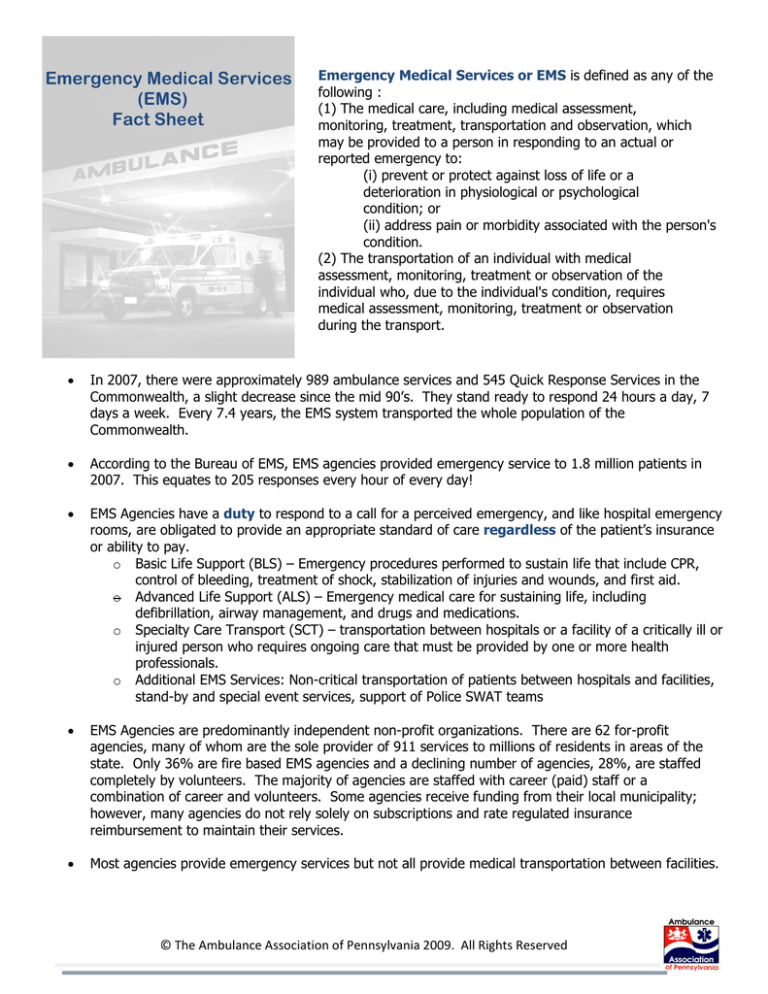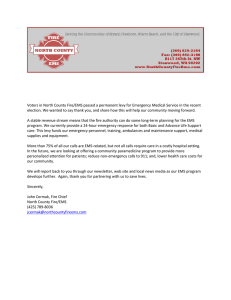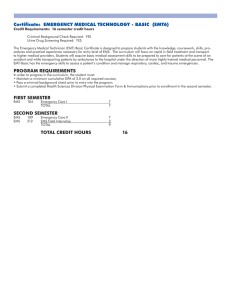
Emergency Medical Services
(EMS)
Fact Sheet
Emergency Medical Services or EMS is defined as any of the
following :
(1) The medical care, including medical assessment,
monitoring, treatment, transportation and observation, which
may be provided to a person in responding to an actual or
reported emergency to:
(i) prevent or protect against loss of life or a
deterioration in physiological or psychological
condition; or
(ii) address pain or morbidity associated with the person's
condition.
(2) The transportation of an individual with medical
assessment, monitoring, treatment or observation of the
individual who, due to the individual's condition, requires
medical assessment, monitoring, treatment or observation
during the transport.
•
In 2007, there were approximately 989 ambulance services and 545 Quick Response Services in the
Commonwealth, a slight decrease since the mid 90’s. They stand ready to respond 24 hours a day, 7
days a week. Every 7.4 years, the EMS system transported the whole population of the
Commonwealth.
•
According to the Bureau of EMS, EMS agencies provided emergency service to 1.8 million patients in
2007. This equates to 205 responses every hour of every day!
•
EMS Agencies have a duty to respond to a call for a perceived emergency, and like hospital emergency
rooms, are obligated to provide an appropriate standard of care regardless of the patient’s insurance
or ability to pay.
o Basic Life Support (BLS) – Emergency procedures performed to sustain life that include CPR,
control of bleeding, treatment of shock, stabilization of injuries and wounds, and first aid.
o Advanced Life Support (ALS) – Emergency medical care for sustaining life, including
defibrillation, airway management, and drugs and medications.
o Specialty Care Transport (SCT) – transportation between hospitals or a facility of a critically ill or
injured person who requires ongoing care that must be provided by one or more health
professionals.
o Additional EMS Services: Non-critical transportation of patients between hospitals and facilities,
stand-by and special event services, support of Police SWAT teams
•
EMS Agencies are predominantly independent non-profit organizations. There are 62 for-profit
agencies, many of whom are the sole provider of 911 services to millions of residents in areas of the
state. Only 36% are fire based EMS agencies and a declining number of agencies, 28%, are staffed
completely by volunteers. The majority of agencies are staffed with career (paid) staff or a
combination of career and volunteers. Some agencies receive funding from their local municipality;
however, many agencies do not rely solely on subscriptions and rate regulated insurance
reimbursement to maintain their services. Most agencies provide emergency services but not all provide medical transportation between facilities. •
© The Ambulance Association of Pennsylvania 2009. All Rights Reserved What is needed:
Direct Payment for Services – An issue that has plagued EMS for years, the 911 call is placed by a resident and the
closest available EMS agency is dispatched. In an emergent situation, the resident has no choice, nor would they think to
ask if the ambulance participates with their insurance. EMS provides this service, regardless of the patient’s insurance or
lack thereof. Residents can be confused when they receive a check from their insurer and many times, keep these
needed funds. Many EMS agencies have difficulty collecting these debts that for some services are tens of thousands of
dollars. The AAP is currently collecting data on the scope and financial impact of this issue.
Co-payment and deductibles – Uncollectible at the time of the emergency, co-payment and deductibles are difficult to
collect. Residents are confused and feel they have paid the hospital and therefore have paid the co-payment for the
emergency. Rising co-payments are shifting the cost of services to the patient. In the case of a chronically ill person
who is transported by an ambulance several times, that person is responsible for a co-payment that could be as high as
$150 per trip, thus penalizing the truly ill resident. The AAP is also collecting data on the scope and financial impact of
this issue.
Increased Insurance Reimbursement – Many insurers require EMS agencies to provide both emergent and medical
transportation between facilities as a requirement to become a contracted participating provider. In addition, most
insurers will not negotiate the contractual reimbursement and offer a non-negotiated flat rate that is below the cost to
provide the service. Many agencies are not able to enter into an agreement with an insurer if they do not provide both
emergent and medical transportation; however, they must still provide the emergency services to the residents
regardless.
Medical Assistance Relief – The uninsured, under insured, and medical assistance population continue to rise. Medical
Assistance reimbursement remained at the same level for 10 years before the AAP fought for an increase in 2004. An
ever growing population who utilizes the EMS system for more than medical transportation, medical assistance
reimbursement is 52% of the Medicare reimbursement level. The GAO released a report in 2007 that stated that
Medicare reimbursement was 6-17% less than the cost to provide the service. The AAP is developing a white paper that
will outline this issue in more detail.
Myth of Medicare Reimbursement Rates – The Medicare Reimbursement rate is constantly used as a standard for
rate regulation of fees for ambulance services. In the Commonwealth, auto insurance and Workman’s Compensation
reimbursement for ambulance service is capped at 110 and 113% respectively of the Medicare Reimbursement rate. In
2008, the Federal Office of Inspector General published a report on the cost of providing ambulance service compared to
the Medicare Ambulance Fee Schedule reimbursement rates. That report showed, on average, the Medicare
Reimbursement Rate for Ambulance Services was 6% to as much as 17% below the cost of providing ambulance service.
Non-traditional Roles – A piece of the future of EMS may lie in an expanded roll of prehospital practitioners into public
health and disease management. EMS has proven valuable from a morbidity and mortality standpoint in emergency
situations, but an even greater impact may be realized through the utilization of prehospital practitioners in disease
management by conducting wellness and compliance checks.
The Ambulance Association of Pennsylvania (AAP) is the lead organization serving the needs of its members in the emergency and nonemergency ambulance and medical transportation industry.
The AAP advocates the highest quality patient care through ethical and sound business practices, advancing the interests of its
members in important legislative, educational, regulatory and reimbursement issues. In accomplishing this goal, AAP is dedicated to
excellence in providing superior service to all facets of its membership and in developing positive
relationships with other organizations involved in the medical transportation field.
In carrying out this mission, the AAP is committed to meet the needs of its members in the volunteer, non-profit and for-profit sectors.
For more information, please contact us at 1-888-714-6484 or www.aa-pa.org
© The Ambulance Association of Pennsylvania 2009. All Rights Reserved





